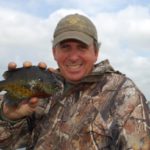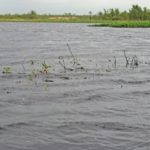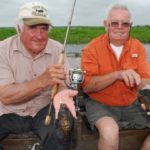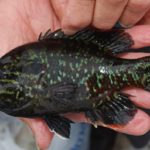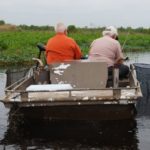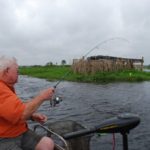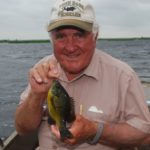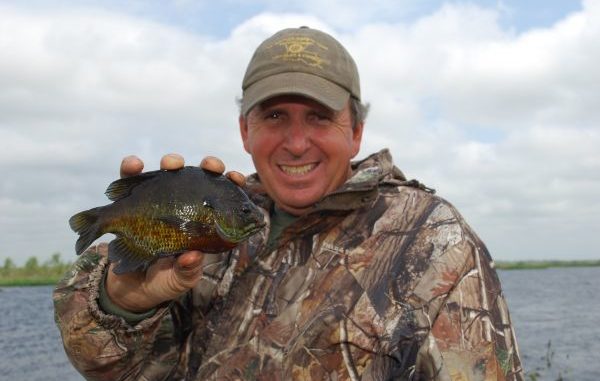
Lake Boeuf north of Raceland is famous for its panfishing — and for being difficult to fish effectively. Here’s how some old-timers catch boatloads of fish.
One hundred-thirty years of experience.
That’s what my friend Dirk Matherne, no spring chicken himself at 58, had fixed me up with. It was a little intimidating, listening to the two silver-maned old lions comparing notes with Mike Adams, a Raceland dentist and Lake Boeuf lover.
The younger of the pair, at only 73, was Steve Bourgeois. He’s been fishing the lake for 63 years. His uncle, Andrew Blanchard, at 82 didn’t start fishing the lake until he was 15, so he only has 67 years of experience.
“I used to paddle a pirogue from the launch to the lake to fish,” Blanchard recalled. “That’s four miles. Sometimes people with motors would take mercy and pick me up. They called me ‘the little fisherman.’”
Both men are retired Avondale employees. Both live in Raceland. Both call Lake Boeuf their “backyard.”
The lake is notoriously hard to fish, shallow, weedy and with vast tracts of constantly shifting flotant—terrain that isn’t really terrain at all, but floating islands of vegetation too thin to walk on and too thick to run a boat through.
But Lake Boeuf is near-legendary in South Louisiana as a productive crappie, redear sunfish (aka chinquapin or lake runner), bluegill, and google-eye hole.
The temperamental lake can be awesomely good or it can be sour as a lemon.
I was out to learn its secrets.
Launching at Theriot Canal was certainly no wilderness experience. The canal is really a big drainage ditch with a well-worn launch at its intersection with Highway 308 in Raceland. For more than two miles, the ditch traversed sugar cane fields.
At two points the boat had to pass through tiny, low, one-boat-wide gaps under dilapidated bridges. One bridge was marked with a white cross, denoting the location where some unfortunate soul left this world in a boating accident.
It felt like the bridge of no return.
Gradually, though, the cane fields gave way to a more photogenic willow and cypress swamp. The canal widened, and its murky waters became clear and blackish green. Finally, right before the canal entered the lake, the swamp gave way to a vibrant, green, freshwater marsh.
The lake that opened in front of the two-boat caravan was more green then blue. The masses of freshwater vegetation made boat travel in a straight line between any two points difficult. It was big too — the other side was visible, but at a distance.
Every part of the lake was speckled with now-unused duck blinds, all of them big enough to drive a boat into. While they are called “duck blinds,” most of them are used to hunt Lake Boeuf’s most-famous migratory bird, the coot — better known locally as poule d’eau.
The blinds provided both valuable landmarks to find fishing areas and very often were fishing destinations for the two men. Their first stop was very near one such ramshackle blind.
Before Matherne could get his anchor down and rod rigged for a cast, the silver-haired pair, sitting side-by-side on the boat’s middle bench seat and facing forward, had hooked, landed and stowed five big bull bluegills and a huge male lake runner. All six fish were decked out in gorgeous spawning colors.
They fished with such efficiency of purpose and with so little wasted motion that it was easy to watch them fish instead of wetting a line oneself; they had obviously fished together a lot and each knew exactly what the other was going to do, like a person’s right hand knows what his left hand is doing.
Both men used earthworms for bait, pinched or cut into 1-inch pieces. Each man had a block of synthetic foam sponge, moistened in the water and then squeezed to remove excess water. The sponge block had a slit cut into its center, forming a pouch.
After each earthworm was in pieces, they were dropped into the moist sponge. The bait was clean, ready for hooking and kept cool and fresh by evaporation from the sponge.
Bourgeois credited Blanchard for this invention, one of many innovations practiced by them.
It was slick as a whistle.
They used medium-weight 6 ½-foot spinning rods and one of three terminal tackle rigs, all of them sweetened with an earthworm tidbit.
One method, favored by Bourgeois, was called a “drop worm.” It was simple: a weighted clip-on cork and a small, long-shank hook — nothing more, nothing less.
Bourgeois called this one of the deadliest methods of fishing in Lake Boeuf, adding that “a weight would cause hang-ups in the moss,” Bourgeois’ catch-all term for any of the large number of aquatic plant species in the lake.
The second method replaced the simple hook with a jighead and one of the huge number and variety of plastic grub tails Blanchard carried in a handy plastic tub.
The final method, one that brought a sparkle to Blanchard’s eye, was to dispense with the cork and toss a tiny safety pin spinner. Blanchard is not afraid to be innovative and will sometimes clip off pieces of the spinner blade to produce a different action from the lure. Blanchard is quite a tinkerer, and ties his own hair jigs for sac-a-lait fishing.
All three methods produce fish. Some days one works better, and other days another will work. In fact, some days only one of the three will catch fish — which Bourgeois, a strong drop worm advocate, ruefully admitted.
“If spinners work better, I will go over to the dark side,” he said.
Blanchard chuckled in delight in response to Bourgeois’s admission.
The pair fished like terrorists, practicing hit-and-run tactics. They ran to a spot, made a dozen casts and, if they didn’t catch anything, one of them would sing out, “This isn’t good,” and they would pick up their anchor and run to the next spot.
Bam, bam, bam!
One spot after another until they hit fish.
Quite a few spots yielded nothing or maybe one fish. Others gave up more — sometimes many more. Some produced all bluegills (mostly big, colorful males), others yielded a mixture of lake runners and bluegills, and a few spots held almost all lake runners.
Mixed in with these two species were a good number of chunky goggle-eyes.
Lake runners, especially big, slab-sided spawning males easy to spot because of their dark body colors, produced the most excitement in the men.
“When the lake runners are bedded down hard (usually in March), catching 50 big, big, big ones is a good day,” Bourgeois explained. “For medium-sized fish, a good day is when you catch 100 or 200.”
As soon as bites stopped coming and casts to other spots within reach didn’t produce any more fish, they were off again.
“We move a lot,” said Bourgeois in the understatement of the year.
There was a lot of rivalry between the two anglers. Whoever was ahead on the body count at any given moment unmercifully ribbed the other about his fishing ability.
Blanchard is Bourgeois’ uncle, hence his constant reference to him as “Unc.” Bourgeois explained their fishing partnership.
“We had kind of drifted apart,” Blanchard said. “Then, when I retired, I called Unc because I wanted to start fishing more. I told him, ‘You’re a better fisherman than me. I want to pick your brain before you die.’”
Blanchard blushed in embarrassment at the praise, but Bourgeois wasn’t through.
“He is the best sac-a-lait fisherman around,” he said. “We are like brothers now.”
The two have been fishing together regularly for 8 years now.
The boat the two men fish out of is rigged for ease of fishing and efficiency. Most noticeable is a homemade live basket hooked over the side of the gunnel immediately beside each man. Made of stainless steel frames over which mesh bags have been sewn, they allow the fisherman to quickly drop his unhooked catch into the bag without taking the time of opening and closing an ice chest.
The bags looked to be made out of whatever mesh material they had handy. Bourgeois added a caution.
“The mesh needs to be small enough so that snakes can’t get in. They will come eat them fish,” he said.
Periodically during the day they emptied the bags into an ice chest stowed in the stern of the boat.
Another efficiency thing that they had going on was the boat’s anchor system: The anchor, slung from a pulley, was raised and lowered by a pulley system at Bourgeois’ fingertips. No one had to get up from his seat to set or raise the anchor.
Once in a fishing spot, the boat was maneuvered by an electric trolling motor, also strategically placed at Bourgeois’ fingertips on the left side of the boat.
They made fishing look easy.
They used various retrieves to seduce fish into biting. Drop worms and worms on plastic grub jigs were worked with a cast — pull in — pause — pull in retrieve that was repeated until the bait was near the boat.
Seldom did a worm set long in one spot.
Worm-tipped spinners were retrieved either at a slow, steady pace or with twitches worked into the retrieve.
The beautiful lake was eye candy, a mosaic of almost neon-green plants and blue-black water, and was serenaded by the sounds of life. Over the gentle cackling of poule d’eau and the occasional “ba-roomp” of a bullfrog, boat-tailed grackles protested loudly against our trespassing.
The time came all too quickly for Matherne to return to his dirt excavation business. Blanchard and Bourgeois followed his boat to the entrance to Theriot Canal, stopped, waved good-bye and headed back into the heart of the lake.
Their fishing day was long from over.
